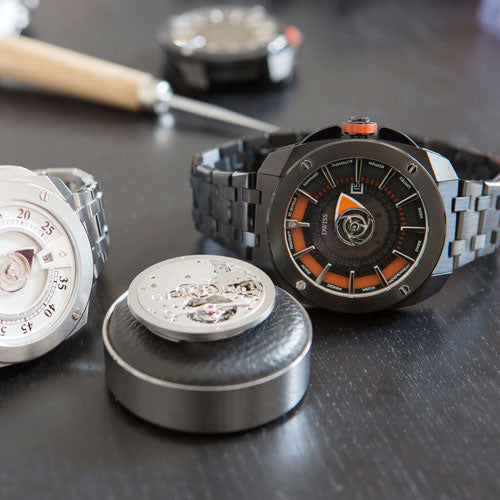HOW TO TAKE GOOD CARE OF AUTOMATIC AND MECHANICAL WATCHES
Proper maintenance and care for mechanical and automatic watches help owners to extend the life of their timepieces and keep them from getting rusted, clogged or slow. Not to mention that cared for and well-maintained watches look great on the wearer’s wrist and compliment his personality.
Useful Tips for Taking Care of a Luxury Mechanical Watch
For the last three hundred years, the fundamental architecture of almost every mechanical watch has remained the same. This is an indication of the true ingenuity of a mechanical luxury watch. In contrast with a quartz watch that derives its energy from batteries or cells, a mechanical watch is powered by manually unwinding a tightly coiled flat spring inside the case. This manual-wind clockwork technology drives the watch hands around the dial while at the same time powers other mechanisms like the date function as well as the chronograph and the moon phase. Some mechanical watch technology can be based on either hand-wind or self-wind movements, or sometimes it can be based on a combination of the two.
A few simple and easy steps can help the micro brands owners maintain the quality and life of their luxury mechanical watches. When they are manually winding their timepieces, the wearer must take care to take the watch off his wrist and then unwind the piece in order to reduce stress on the winding stem. The micro brand watch owner must never overwind the timepiece lest the spring gets broken. He should stop the winding as soon as he can feel the resistance. A micro brand mechanical watch is built for daily use. It must not be kept still for long periods of time, or the intricate clockwork mechanism and its lubricants can cause congealment. Making it a habit to wind one’s watch every day before strapping it to the wrist is another little tip to prolong the life of the timepiece.
A designer mechanical watch is an epitome of classical engineering. It is important to avoid extremes of temperatures when using a mechanical watch, such as going out in freezing cold or going in a hot sauna while wearing one. Extreme cold or hot environments can cause the mechanical timepiece’s sensitive parts to expand or contract beyond their capacity or it can cause unwanted condensation inside the case. Similarly, harsh weather conditions can cause the lubricants to watch parts to clot and congeal.
No one wants to wear a dirty watch. Sometimes dust particles and debris can work their way inside a mechanical watch, making it look old and unattractive. The best way to tackle dust and dirt in watches is to use a microfiber polishing cloth to get rid of all that grime. A little water can do too, but the owner must ensure the crown is tightly secured before proceeding with his cleaning ritual.
Useful Tips for Automatic Watch Care and Maintenance
Having a great watch to wear is in itself an achievement. By learning to take proper care of one’s luxury watches will help watch owners keep their valuable timepieces in their best condition possible. Always remember that an automatic watch has many enemies, like dirt, dust, moisture and shocks. To make matters worse, exposure to UV radiation or even extreme environments can cause them to malfunction. To take care of an automatic timepiece, a watch enthusiast must be mindful of the watch’s general care, while at the same time must have a basic knowledge of the do’s and don’ts when cleaning any automatic watches.
The most basic maintenance tip is to clean the watch often by wiping the watch’s case, strap or bracelet with a soft piece of cloth. Avoid making too much pressure on the watch glass if the glass is very thin. If it is a water-proof automatic micro brand watch, the wearer can use a mixture of water and soap, but the soap must be mild and only a soft cloth or a cleaning brush with soft bristles should be applied. However, the crown should be checked for its proper position, otherwise, the water can seep inside and cause permanent damage to your automatic timepiece.
While mechanical watches can be wind manually by hand, some collectors uses a watch winder for a luxury automatic watch. Watch winders are easily available with watch distributors and stores and can be bought for as low as $50. It might be interesting to note that certified watch connoisseurs always keep watch winders handy! In addition, preventive care can help automatic watch owners to maintain the robustness and the appearance of their watches for long periods of time. For instance, it goes without saying that watch wearers must remove their timepieces before taking a shower or going for a swim. Even though one might have a water-resistant wristwatch, most watches cannot resist air or withstand high temperatures or hot water.
Most users might think that a watch’s box is just for packaging purposes. They are wrong - a watch’s box can offer these valuable and beautiful timepieces solid protection from dust and shock when they are not in use. Instead of having it sit on the dresser or accumulate dirt at the bottom of a drawer, it is best to let its box hold it for safekeeping. Last but not least, a designer automatic watch should be taken to a professional for service from time to time to get lubrified.
Although such a practice is usually made every 5 to 10 years, taking the watch to a professional when needed helps ensure that any worn out or damaged parts are immediately replaced, which can strengthen the watch’s overall performance.




Share:
What drove DWISS here?
CALIBER ETA 7001 TOP GRADE